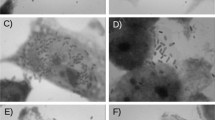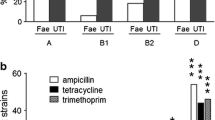Abstract
Uropathogenic Escherichia coli (UPEC) strains are found in high numbers in the gut of patients with urinary tract infections (UTIs). We hypothesised that in hospitalised patients, UPEC strains might translocate from the gut to the blood stream and that this could be due to the presence of virulence genes (VGs) that are not commonly found in UPEC strains that cause UTI only. To test this, E. coli strains representing 75 dominant clonal groups of UPEC isolated from the blood of hospitalised patients with UTI (urosepsis) (n = 22), hospital-acquired (HA) UTI without blood infection (n = 24) and strains isolated from patients with community-acquired (CA)-UTIs (n = 29) were tested for their adhesion to, invasion and translocation through Caco-2 cells, in addition to the presence of 34 VGs associated with UPEC. Although there were no differences in the rate and degree of translocation among the groups, urosepsis and HA-UTI strains showed significantly higher abilities to adhere (P = 0.0095 and P < 0.0001 respectively) and invade Caco-2 cells than CA-UTI isolates (P = 0.0044, P = 0.0048 respectively). Urosepsis strains also carried significantly more VGs than strains isolated from patients with only UTI and/or CA-UTI isolates. In contrast, the antigen 43 allele RS218 was found more commonly among CA-UTI strains than in the other two groups. These data indicate that UPEC strains, irrespective of their source, are capable of translocating through gut epithelium. However, urosepsis and HA-UTI strains have a much better ability to interact with gut epithelia and have a greater virulence potential than CA-UPEC, which allows them to cause blood infection.



Similar content being viewed by others
References
Martin GS, Mannino DM, Eaton S, Moss M (2003) The epidemiology of sepsis in the United States from 1979 through 2000. N Engl J Med 348(16):1546–1554
Mora-Rillo M, Fernandez-Romero N, Francisco CN, Diez-Sebastian J, Romero-Gomez MP, Fernandez FA et al (2015) Impact of virulence genes on sepsis severity and survival in Escherichia coli bacteremia. Virulence 6(1):93–100
MacFie J, O'Boyle C, Mitchell CJ, Buckley PM, Johnstone D, Sudworth P (1999) Gut origin of sepsis: a prospective study investigating associations between bacterial translocation, gastric microflora, and septic morbidity. Gut 45(2):223–228
Skjot-Rasmussen L, Ejrnaes K, Lundgren B, Hammerum AM, Frimodt-Moller N (2012) Virulence factors and phylogenetic grouping of Escherichia coli isolates from patients with bacteraemia of urinary tract origin relate to sex and hospital- vs. community-acquired origin. Int J Med Microbiol 302(3):129–134
Russo TA, Johnson JR (2003) Medical and economic impact of extraintestinal infections due to Escherichia coli: focus on an increasingly important endemic problem. Microbes Infect 5(5):449–456
Lefort A, Panhard X, Clermont O, Woerther PL, Branger C, Mentre F et al (2011) Host factors and portal of entry outweigh bacterial determinants to predict the severity of Escherichia coli bacteremia. J Clin Microbiol 49(3):777–783
Krawczyk B, Sledzinska A, Szemiako K, Samet A, Nowicki B, Kur J (2015) Characterisation of Escherichia coli isolates from the blood of haematological adult patients with bacteraemia: translocation from gut to blood requires the cooperation of multiple virulence factors. Eur J Clin Microbiol Infect Dis 34(6):1135–1143
Ron EZ (2010) Distribution and evolution of virulence factors in septicemic Escherichia coli. Int J Med Microbiol. 300(6):367–370
Palaniappan RU, Zhang Y, Chiu D, Torres A, Debroy C, Whittam TS et al (2006) Differentiation of Escherichia coli pathotypes by oligonucleotide spotted array. J Clin Microbiol 44(4):1495–1501
Pettersen VK, Mosevoll KA, Lindemann PC, Wiker HG (2016) Coordination of metabolism and virulence factors expression of Extraintestinal pathogenic Escherichia coli purified from blood cultures of patients with sepsis. Mol Cell Proteomics 15(9):2890–2907
Lu L, Walker WA (2001) Pathologic and physiologic interactions of bacteria with the gastrointestinal epithelium. Am J Clin Nutr 73(6):1124S–1130S
Diacovich L, Gorvel JP (2010) Bacterial manipulation of innate immunity to promote infection. Nat Rev Microbiol 8(2):117–128
Jaureguy F, Carbonnelle E, Bonacorsi S, Clec'h C, Casassus P, Bingen E et al (2007) Host and bacterial determinants of initial severity and outcome of Escherichia coli sepsis. Clin Microbiol Infect 13(9):854–862
Vollmerhausen TL, Katouli M (2014) Molecular characterisation of Escherichia coli isolated from hospitalised children and adults with urinary tract infection. Eur J Clin Microbiol Infect Dis 33(6):975–982
Ulett GC, Totsika M, Schaale K, Carey AJ, Sweet MJ, Schembri MA (2013) Uropathogenic Escherichia coli virulence and innate immune responses during urinary tract infection. Curr Opin Microbiol 16(1):100–107
Johnson JR, Stell AL (2000) Extended virulence genotypes of Escherichia coli strains from patients with urosepsis in relation to phylogeny and host compromise. J Infect Dis 181(1):261–272
Maslow JN, Mulligan ME, Adams KS, Justis JC, Arbeit RD (1993) Bacterial adhesins and host factors: role in the development and outcome of Escherichia coli bacteremia. Clin Infect Dis 17(1):89–97
Wagenlehner FM, Lichtenstern C, Rolfes C, Mayer K, Uhle F, Weidner W et al (2013) Diagnosis and management for urosepsis. Int J Urol 20(10):963–970
Bone RC, Balk RA, Cerra FB, Dellinger RP, Fein AM, Knaus WA et al (1992) Definitions for sepsis and organ failure and guidelines for the use of innovative therapies in sepsis. The ACCP/SCCM consensus conference committee. American College of Chest Physicians/Society of Critical Care Medicine. Chest 101(6):1644–1655
Tunn UW, Thieme H (1982) Sepsis associated with urinary tract infection. Antibiotic treatment with piperacillin. Arch Intern Med 142(11):2035–2038
McNally A, Alhashash F, Collins M, Alqasim A, Paszckiewicz K, Weston V et al (2013) Genomic analysis of extra-intestinal pathogenic Escherichia coli urosepsis. Clin Microbiol Infect 19(8):E328–E334
Melekos MD, Naber KG (2000) Complicated urinary tract infections. Int J Antimicrob Agents 15(4):247–256
Ljungdahl M, Lundholm M, Katouli M, Rasmussen I, Engstrand L, Haglund U (2000) Bacterial translocation in experimental shock is dependent on the strains in the intestinal flora. Scand J Gastroenterol 35(4):389–397
Bark T, Katouli M, Svenberg T, Ljungqvist O (1995) Food deprivation increases bacterial translocation after non-lethal haemorrhage in rats. Eur J Surg 161(2):67–71
Vollmerhausen TL, Woods JL, Faoagali J, Katouli M (2014) Interactions of uroseptic Escherichia coli with renal (A-498) and gastrointestinal (HT-29) cell lines. J Med Microbiol 63(Pt 12):1575–1583
Moreno E, Andreu A, Pigrau C, Kuskowski MA, Johnson JR, Prats G (2008) Relationship between Escherichia coli strains causing acute cystitis in women and the fecal E. coli population of the host. J Clin Microbiol 46(8):2529–2534
Ramos NL, Saayman ML, Chapman TA, Tucker JR, Smith HV, Faoagali J et al (2010) Genetic relatedness and virulence gene profiles of Escherichia coli strains isolated from septicaemic and uroseptic patients. Eur J Clin Microbiol Infect Dis 29(1):15–23
Gundogdu A, Long YB, Katouli M (2012) Prevalence and pathogenesis of extended-spectrum beta-lactamase producing Escherichia coli causing urinary tract infection in hospitalized patients. Eur J Clin Microbiol Infect Dis 31(11):3107–3116
Clermont O, Bonacorsi S, Bingen E (2000) Rapid and simple determination of the Escherichia coli phylogenetic group. Appl Environ Microbiol 66(10):4555–4558
Knutton S, Lloyd DR, McNeish AS (1987) Adhesion of enteropathogenic Escherichia coli to human intestinal enterocytes and cultured human intestinal mucosa. Infect Immun 55(1):69–77
Vollmerhausen TL, Ramos NL, Gundogdu A, Robinson W, Brauner A, Katouli M (2011) Population structure and uropathogenic virulence-associated genes of faecal Escherichia coli from healthy young and elderly adults. J Med Microbiol 60(Pt 5):574–581
Duncan MJ, Li G, Shin JS, Carson JL, Abraham SN (2004) Bacterial penetration of bladder epithelium through lipid rafts. J Biol Chem 279(18):18944–18951
Snowden L, Wernbacher L, Stenzel D, Tucker J, McKay D, O'Brien M et al (2006) Prevalence of environmental Aeromonas in south East Queensland, Australia: a study of their interactions with human monolayer Caco-2 cells. J Appl Microbiol 101(4):964–975
Restieri C, Garriss G, Locas MC, Dozois CM (2007) Autotransporter-encoding sequences are phylogenetically distributed among Escherichia coli clinical isolates and reference strains. Appl Environ Microbiol 73(5):1553–1562
Aguilar-Duran S, Horcajada JP, Sorli L, Montero M, Salvado M, Grau S et al (2012) Community-onset healthcare-related urinary tract infections: comparison with community and hospital-acquired urinary tract infections. J Inf Secur 64(5):478–483
Horcajada JP, Shaw E, Padilla B, Pintado V, Calbo E, Benito N et al (2013) Healthcare-associated, community-acquired and hospital-acquired bacteraemic urinary tract infections in hospitalized patients: a prospective multicentre cohort study in the era of antimicrobial resistance. Clin Microbiol Infect 19(10):962–968
Marschall J, Fraser VJ, Doherty J, Warren DK (2009) Between community and hospital: healthcare-associated gram-negative bacteremia among hospitalized patients. Infect Control Hosp Epidemiol 30(11):1050–1056
Turck M, Petersdorf RG (1962) The epidemiology of nonenteric Escherichia coli infections: prevalence of serological groups. J Clin Invest 41:1760–1765
Katouli M, Nettebladt CG, Muratov V, Ljungqvist O, Bark T, Svenberg T et al (1997) Selective translocation of coliform bacteria adhering to caecal epithelium of rats during catabolic stress. J Med Microbiol 46(7):571–578
Murphy SF, Thumbikat P (2015) The importance of the "V"-factor: Escherichia coli bacteremia and sepsis. Virulence 6(2):107–108
Abgottspon D, Ernst B (2012) In vivo evaluation of FimH antagonists—a novel class of antimicrobials for the treatment of urinary tract infection. Chimia (Aarau) 66(4):166–169
Antao EM, Wieler LH, Ewers C (2009) Adhesive threads of extraintestinal pathogenic Escherichia coli. Gut Pathog 1(1):22
Owrangi B, Masters N, Vollmerhausen TL, O'Dea C, Kuballa A, Katouli M (2017) Comparison between virulence characteristics of dominant and non-dominant Escherichia coli strains of the gut and their interaction with Caco-2 cells. Microb Pathog 105:171–176
Klemm P, Hjerrild L, Gjermansen M, Schembri MA (2004) Structure-function analysis of the self-recognizing antigen 43 autotransporter protein from Escherichia coli. Mol Microbiol 51(1):283–296
Author information
Authors and Affiliations
Corresponding author
Ethics declarations
Informed consent
It is certified that all authors designated in this manuscript have read the contents and agreed with its submission to the European Journal of Clinical Microbiology & Infectious Diseases.
Transparency declarations
None to declare.
Conflicts of interest
The authors declare that there are no conflicts of interest with the organisation that sponsored this research and publications arising from this research.
Rights and permissions
About this article
Cite this article
Owrangi, B., Masters, N., Kuballa, A. et al. Invasion and translocation of uropathogenic Escherichia coli isolated from urosepsis and patients with community-acquired urinary tract infection. Eur J Clin Microbiol Infect Dis 37, 833–839 (2018). https://doi.org/10.1007/s10096-017-3176-4
Received:
Accepted:
Published:
Issue Date:
DOI: https://doi.org/10.1007/s10096-017-3176-4




